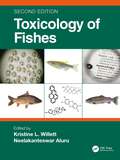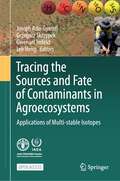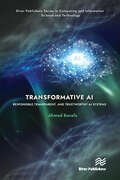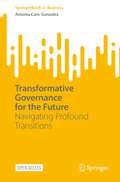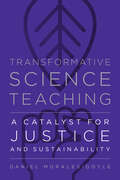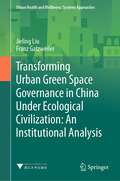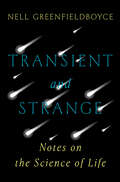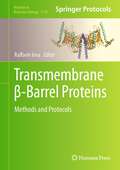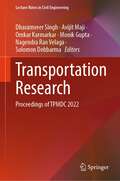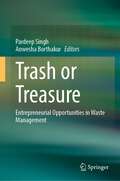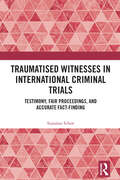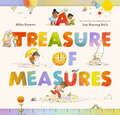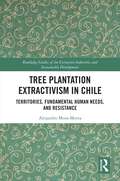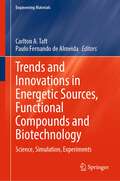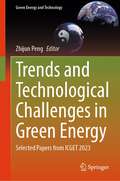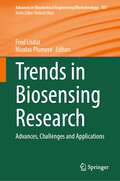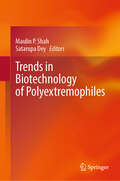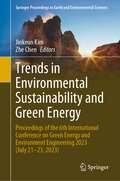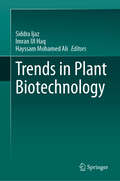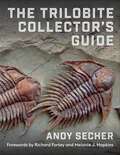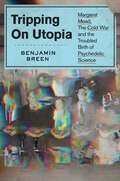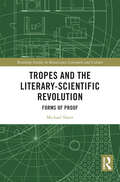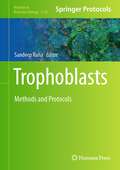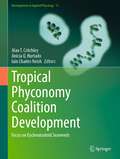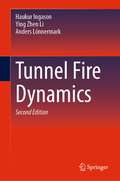- Table View
- List View
Toxicology of Fishes
by Kristine L. Willett Neelakanteswar AluruThis up-to-date, comprehensive toxicology handbook is devoted to the effects of environmental pollution on fish. Fish species represent nearly half of all vertebrates and have become important sentinels for environmental contamination and model organisms for understanding adverse outcomes from exposures. This new edition is written by recognized experts, and it highlights the significant research progress in fish toxicology that has resulted from rapid technological developments in analytical, biochemical, and genomic sciences. The book: Discusses fundamental topics such as toxicokinetics in fishes, processes governing biotransformation within these organisms, and reactive oxygen species and oxidative stress. Explains key target organ systems for chemical impacts in fish, such as the nervous and immune systems, and how fishes can develop resistance to chemical toxicity. Covers multi-transgenerational effects on fishes, epigenetics, proteomics and metabolomics, and adverse outcome pathways. Replacing the case studies in the first edition, this update delves into the impacts of microplastics, pharmaceuticals, and oil spills in dedicated final chapters. With nearly 200 illustrations and tables, this comprehensive reference work presents concepts in a way that is useful for both novices to and experts in the field of fish toxicology.
Tracing the Sources and Fate of Contaminants in Agroecosystems: Applications of Multi-stable Isotopes
by Lee Heng Joseph Adu-Gyamfi Grzegorz Skrzypek Gwenaël ImfeldThe objective of this open access book is to present protocols, methodologies, and standard operating procedures (SOPs) used for the identification of sources, transport, and fate of agro-contaminants and illustrate them with several case studies of successful applications. The Soil and Water Management & Crop Nutrition (SWMCN) Subprogramme of the Joint Food and Agriculture Organization (FAO)/International Atomic Energy Agency (IAEA) Centre of Nuclear Techniques in Food and Agriculture, through a Coordinated Research Project (CRP) in partnership with national and international research institutes, developed and evaluated a set of analytical techniques (the toolbox). The toolbox integrates multiple isotope tracers that provide information on the origins and pathways of multiple pollutants through agro-ecosystems, thereby providing more accurate guidance on mitigations. However, land management strategies to address and control the transport of pollutants from soil to water bodies remain the shared responsibility of farm and aquaculture operators, agro-chemical manufacturers, and policymakers in food and agriculture as well as the mining sectors. This book is structured into eight chapters covering (i) an overview of the book’s content, (ii) guidelines for designing water sampling programmes, (iii) the use of mixing models applicable to tracers for water pollution studies, (iv) compound-specific isotope analyses to investigate pesticide degradation in agricultural catchments, (v) the use of stable oxygen isotope composition of phosphate to investigate phosphorous in soil-plant continuum, (vi) the use of stable sulphur isotopes to disentangle agro-pollutants from other contaminants, (vii) nuclear tools used in sediment source apportionment, and (viii) the conclusions and perspectives forward. The book offers up-to-date information, and we hope it is a great source of information for students, researchers, and policymakers. The SWMCN subprogramme thanks all the contributors involved in the preparation of this publication.
Transformative AI: Responsible, Transparent, and Trustworthy AI systems (River Publishers Series in Computing and Information Science and Technology)
by Ahmed BanafaTransformative Artificial Intelligence provides a comprehensive overview of the latest trends, challenges, applications, and opportunities in the field of Artificial Intelligence. The book covers the state of the art in AI research, including machine learning, natural language processing, computer vision, and robotics, and explores how these technologies are transforming various industries and domains, such as healthcare, finance, education, and entertainment.The book also addresses the challenges that come with the widespread adoption of AI, including ethical concerns, bias, and the impact on jobs and society. It provides insights into how to mitigate these challenges and how to design AI systems that are responsible, transparent, and trustworthy.The book offers a forward-looking perspective on the future of AI, exploring the emerging trends and applications that are likely to shape the next decade of AI innovation. It also provides practical guidance for businesses and individuals on how to leverage the power of AI to create new products, services, and opportunities.Overall, the book is an essential read for anyone who wants to stay ahead of the curve in the rapidly evolving field of Artificial Intelligence and understand the impact that this transformative technology will have on our lives in the coming years.
Transformative Governance for the Future: Navigating Profound Transitions (SpringerBriefs in Business)
by Antonia Caro-GonzalezThis open access book helps actors who are committed to change unlock true innovative potential for the common good in their organizations. Innovation and change processes are not linear. Hence, this book presents a novel way to manage complexity. The author introduces readers to a comprehensive change management framework, the Eoh-for-Good blueprint methodology. It presents the method and discusses how it can be used to support collaboration, overcome challenges and achieve lasting changes in organizations with a 360-degree approach combining top-down, middle-round and bottom-up collaborative perspectives.
Transformative Science Teaching: A Catalyst for Justice and Sustainability
by Daniel Morales-DoyleA call to action championing equity and social justice in K–12 science curriculum
Transforming Urban Green Space Governance in China Under Ecological Civilization: An Institutional Analysis (Urban Health and Wellbeing)
by Jieling Liu Franz GatzweilerThis book addresses the transdisciplinary subject of urban green space governance in Chinese cities through political sciences, organization theory, sociology, and new institutional economics lenses, with urban planning and ecology perspectives as research foundation and the science of climate change on health and wellbeing research background. It captivates readers by bringing answers to: 1) Why are urban green spaces such a highly contested subject in climate mitigation and adaptation, particularly in contexts like Chinese cities? 2) Why is it important to govern urban green spaces as common-pool resources? 3) How to design policies/institutions that can maximize the end objectives such as good health, wellbeing, and climate resilience? 4) What can ordinary citizens gain from caring more about greening their cities and contributing to the process? Besides, the methods used in this research-case-based study - qualitative in-depth interviews and qualitative content analysis using the mainstream qualitative data analysis software MaxQDA, are valuable learning sources, especially for junior graduate students. The book features three in-depth case studies with rich interview and illustration materials and a range of graphics of higher analytical quality. Readers both from research professionals to non-academics with a general cultural interest in geography would find this work instructive and informative.
Transient and Strange: Notes on the Science of Life
by Nell GreenfieldboyceAn astonishing debut from the beloved NPR science correspondent: intimate essays about the intersection of science and everyday life. In her career as a science reporter, Nell Greenfieldboyce has reported from inside a space shuttle, the bottom of a coal mine, and the control room of a particle collider; she’s presented news on the color of dinosaur eggs, ice worms that live on mountaintop glaciers, and signs of life on Venus. In this, her debut book, she delivers a wholly original collection of powerful, emotionally raw, and unforgettable personal essays that probe the places where science touches our lives most intimately. Expertly weaving her own experiences of motherhood and marriage with an almost devotional attention to the natural world, Greenfieldboyce grapples with the weighty dualities of life: birth and death, constancy and impermanence, memory and doubt, love and aging. She looks for a connection to the universe by embarking on a search for the otherworldly glint of a micrometeorite in the dust, consults meteorologists and storm chasers on the eerie power of tornadoes to soothe her children’s anxieties, and processes her adolescent oblivion through the startling discovery of black holes. Inspired throughout by Walt Whitman’s invocation to the “transient and strange,” she remains attuned to the wildest workings of our world, reflecting on the incredible leap of the humble flea or the echoing truth of a fetal heartbeat. A beautiful blend of explanatory science, original reporting, and personal experience, Transient and Strange captures the ache of ordinary life, offering resonant insights into both the world around us and the worlds within us.
Transmembrane β-Barrel Proteins: Methods and Protocols (Methods in Molecular Biology #2778)
by Raffaele IevaThis detailed volume explores experimental strategies and protocols for the expression, assembly, characterization, and exploitation of transmembrane β-barrel proteins. Beginning with methodologies to study their assembly, the book continues with protocols for characterizing the landscape of transmembrane β-barrel protein interactions with other cellular factors, dissecting processes of protein transport in bacteria and mitochondria, examining structural characterization, determination, and prediction, and more. Written for the highly successful Methods in Molecular Biology series, chapters include introductions to their respective topics, lists of the necessary materials and reagents, step-by-step and readily reproducible laboratory protocols, and tips on troubleshooting and avoiding known pitfalls. Authoritative and practical, Transmembrane β-Barrel Proteins: Methods and Protocols serves as an ideal guide for researchers seeking to expand our knowledge of these vital membrane-spanning proteins.
Transportation Research: Proceedings of TPMDC 2022 (Lecture Notes in Civil Engineering #434)
by Dharamveer Singh Avijit Maji Omkar Karmarkar Monik Gupta Nagendra Rao Velaga Solomon DebbarmaThis book is a collection of selected research papers from the 14th conference of the Transportation Planning and Implementation Methodologies for Developing Countries (TPMDC). It covers the broad area of transportation planning and policy, pavement design and engineering, emerging technologies in transportation, traffic management, operations, and safety, and sustainable mobility in transportation. The book aims to provide deeper understanding of the transportation issues, solutions, and learnings from the implemented solutions. This book will be of best interest for academicians, researchers, policy makers, and practitioners.
Trash or Treasure: Entrepreneurial Opportunities in Waste Management
by Pardeep Singh Anwesha BorthakurIn this book, we have contributions from experts working on diverse aspects of waste management and waste entrepreneurship with an aim to contribute toward a holistic understanding of the existing and forthcoming waste handling challenges. Waste entrepreneurship refers to the practice of creating and operating businesses that aim to address the problem of waste management. It signifies businesses that are dedicated to finding innovative solutions for managing waste and plays a crucial role in building a sustainable future. Waste entrepreneurs identify waste as a valuable resource and use state-of-the-art tactics to reduce, reuse, recycle, and re-purpose it. By developing new technologies, services, and products that help reduce waste and recycle materials, they can create new economic opportunities while simultaneously reducing the environmental impact of waste. The primary audience of this book are researchers (from a wide range of disciplinary backgrounds) working in the field of waste management (especially E-waste, Plastics, Paper and Cardboard Waste, Organic Waste, and Construction and Demolition Waste) and environmental sustainability. This book also contains descriptions of various facets of waste entrepreneurship from different countries which will be helpful for different entrepreneurs looking for business opportunities in the waste management sector, NGOs, government agencies, international agencies, and new researchers working in the related fields. In particular, the book could provide start-up ideas to the enthusiastic readers.
Traumatised Witnesses in International Criminal Trials: Testimony, Fair Proceedings, and Accurate Fact-Finding
by Suzanne SchotThis book focuses on the testimonial evidence of traumatised witnesses in trials of international crimes, which deal with acts of genocide, war crimes and crimes against humanity. Such trials often involve the testimonies of those who experienced or witnessed extremely traumatic events, which can make it hard for these witnesses to recall specific details. Testifying during trial may in itself also pose challenges to their well-being. Yet the legal process of determining whether someone can be held criminally responsible for the alleged crimes needs to be fair, in accordance with the right to a fair trial of the accused, and the facts need to be determined as accurately as possible. This book argues that to ensure fair and accurate fact-finding when in particular traumatised witnesses testify, a balance needs to be struck between the needs of witnesses who testify about traumatic experiences, the fair trial rights of the accused and the objective of the court to establish as accurately as possible the responsibility of the accused. This is crucial throughout the stages of selecting, preparing, presenting and assessing the testimonial evidence of traumatised witnesses. The methodology involves an analysis of transcripts of proceedings and case law of the International Criminal Tribunal for the former Yugoslavia, the International Criminal Court and Dutch courts prosecuting international crimes. The research demonstrates that it is often difficult to strike a balance between the competing objectives during proceedings when traumatised witnesses testify due to the current lack of regulations and guidelines applicable during investigations and prosecutions. This book shows that this balance can, and should, be achieved when traumatised witnesses testify during criminal proceedings for international crimes. The work is an invaluable resource for researchers, academics and practitioners in criminal law, criminology, legal psychology, legal psychiatry, social anthropology and forensic sciences.
A Treasure of Measures
by Mike DownsThere are so many little life moments to measure—and so many creative ways to measure them!How do you measure how long it takes to read a good book? Sure, you can use units of time, like minutes or hours . . . but you can also use your very own measurements: how many times you laugh or cry, how many pages you turn, or how many times you ask to read it again. And measuring rainfall could mean using decibels of sound . . . or how many people you see opening umbrellas. This playful picture book introduces young readers to different units of measurement, then invites them to think of creative ways to quantify the meaningful moments in their lives. The possibilities are as limitless as the imagination!ENCOURAGES CURIOSITY: Every kid loves to count, measure, and quantify—even when the things they’re examining seem immeasurable at first glance! This nonfiction picture book encourages kids’ natural inclinations toward scientific thinking and their boundless imaginations, modeling unique ways to measure everything from the distance covered on a road trip to the brightness of stars and more!CELEBRATES SEEING AND EXPERIENCING: This charmingly illustrated book is a celebration of what is special about every day, no matter how small those moments may seem. Measuring is one way to really take in a new experience, after all. Kids will embrace the concept and the fun!ENGAGING READ-ALOUD: This picture book’s accessible rhyme, engaging content, and spirited illustrations make it a delightful read-aloud for classroom or family enjoyment.A SWEET GIFT BOOK: A meaningful message and adorable illustrations make this a go-to gift and an ideal addition to a child's library.Perfect for:Parents, grandparents, and caregivers of curious kidsLibrarians and teachers seeking engaging nonfiction books with STEM or STEAM contentAnyone seeking a distinctive gift that encourages imagination, creativity, and playBirthday, holiday, summer reading, or moving-up ceremony gift
Tree Plantation Extractivism in Chile: Territories, Fundamental Human Needs, and Resistance (Routledge Studies of the Extractive Industries and Sustainable Development)
by Alejandro Mora-MottaThis book examines how extractivism transforms territories and affects the well-being of rural people, drawing on in-depth fieldwork conducted on tree plantations in Chile.The book argues that pine and eucalyptus monoculture plantations in southern Chile are a form of extractivism representing a mode of nature appropriation that captures large amounts of natural resources to produce wooden-based raw materials with little processing and an export-oriented focus. The book discusses the nexus of extractivism, territorial transformations, well-being, and emerging resistances using a participatory action research methodological approach in the Region of Los Ríos, southern Chile. The findings show how the configuration of an extractivist logging enclave generated a substantial and irrevocable reordering of human-nature relations, resulting in the territorial and ontological occupation of rural places that disrupted the fundamental human needs of peasants and indigenous people. The book maintains that Chile's green growth development approach does not challenge the consolidated tree plantation enclave controlled by large multinationals. Instead, green growth legitimises the extractivist logic. The book draws parallels with other countries and regions to contribute to wider debates surrounding these topics.This book will be of great interest to students and scholars of the extractive industries, development studies, political ecology, and natural resource governance.
Trends and Innovations in Energetic Sources, Functional Compounds and Biotechnology: Science, Simulation, Experiments (Engineering Materials)
by Carlton A. Taft Paulo Fernando de AlmeidaThis book offers a roadmap to the future, addressing pressing challenges such as energy sustainability, environmental preservation, and advancements in biotechnology and pharmaceuticals. From the exploration of novel perovskite materials for environmental NO reduction to the development of game-changing biotechnological strategies for simultaneous CO2 capture and H2S conversion, this book spans a diverse range of topics. The content dives into the realms of artificial intelligence, nanotechnology, and state-of-the-art photovoltaic solar cells. The chapters explore the potential of psychedelic substances for treating mental disorders and the use of computational tools in pesticide development. Moreover, the reader can uncover the secrets of copaiba tree oil-resin active ingredients with multifaceted medicinal properties and the application of electrical current in alcoholic fermentation. With contributions from esteemed researchers, this book offers insights into the forefront of scientific progress.
Trends and Technological Challenges in Green Energy: Selected Papers from ICGET 2023 (Green Energy and Technology)
by Zhijun PengTrends and Technological Challenges in Green Energy: Selected Papers from ICGET 2023 offers readers selected and expanded papers from the 2023 8th International Conference on Green Energy Technologies held at the University of the Applied Sciences in Hamburg, Germany. It features innovative work by academics, researchers, and industry experts highlighting the latest renewable energy developments. The book covers fundamental and practical applications for green energy resources, including security, energy consumption, localization, energy access, environment-friendly energy systems, sustainable energy development, energy-saving technologies, and conservation. It is a valuable interdisciplinary reference for young researchers, postgraduate students, professionals, and industry practitioners working with green energy technology and applications.
Trends in Biosensing Research: Advances, Challenges and Applications (Advances in Biochemical Engineering/Biotechnology #187)
by Fred Lisdat Nicolas PlumeréThis book reviews the latest developments and applications in the field of biosensing, providing readers with an update of the earlier, successful edition, Biosensing for the 21st Century. In this book, readers will find comprehensive key information on the advances and challenges in biorecognition elements and transduction principles, including examples of new materials and new methods. Ranging from engineering chimeric enzymes to the progress in electrochemical sensing of drugs, the book discusses the latest innovations in the field and thus, provides the reader with a profound overview. In the field of biological recognition the focus will be on switchable sensors by engineering new proteins, the development of Molecular Imprinted Polymers (MIPs) for proteins or even larger biological entities, the construction of complex nucleic acid – protein structures for affinity sensing and the application of whole microbes. The book covers new trends in signal transduction which includes graphene-based field effect transistors, nanopores designed for high selectivity and sensitivity in analysis, plasmonic and nanophotonic sensing applying metal nanostructures up to new developments in microarray construction. An introduction in to the challenges in skin-interfaced systems for continuous biochemical sensing, offers a glimpse into the future of wearable technologies. Furthermore, actual areas of application of new sensing strategies such as the detection of various types of viruses and bacteria or the analysis of drugs will be highlighted. Each chapter provides a scholarly yet accessible perspective on the latest trends in biosensor technology. Given its breadth, the book has an interdisciplinary appeal and engages a wide readership, from students and researchers to practitioners in academia and industry, interested in the fields of biochemical/biomedical engineering and in biosensing methodologies and applications.
Trends in Biotechnology of Polyextremophiles
by Maulin P. Shah Satarupa DeyThis book covers polyextremophiles, the latest biotechnological advances, and developments in the study of extremophilic diversity with a focus on genetics, proteomics and the impact of climate change. It sets out new perspectives on the polyextremophiles' mechanism of tolerance to extreme conditions, and it also outlines their applications in bioremediation, therapeutics, and astrobiology research. Expert contributors discuss topics such as genes associated with polyextremophiles, the applications of genome editing in extremophiles, secondary metabolites from extremophiles, and the biocatalytic potential of extemozymes isolated from extremophiles. Readers will find in this book several case studies that collate the diverse applications of polyextremophiles for bioremediation, including the use of extremophilic algae in wastewater treatment, nutrient recovery and animal feed production, the treatment of industrial waste, pharmaceuticals and personal care products, and the removal of microplastics, heavy metals and E-waste. Particular attention is given to the use of polyextremophiles for bioremediation of abandoned mining sites. The book also presents bioactive compounds from halophiles and their biomedical applications and discusses the implications of polyextremophiles in astrobiology research. Given its breadth, this book is a valuable contribution to the biotechnology of polyextremophiles by overviewing research to date and exploring challenges and opportunities for future research. It also benefits a broad readership, from scholars, researchers and students to industry professionals interested in the study and development of biotechnological applications of polyextremophiles.
Trends in Environmental Sustainability and Green Energy: Proceedings of the 6th International Conference on Green Energy and Environment Engineering 2023 (July 21-23, 2023) (Springer Proceedings in Earth and Environmental Sciences)
by Jinkeun Kim Zhe ChenThis book offers a collection of papers presented at the 2023 6th International Conference on Green Energy and Environment Engineering (CGEEE 2023), held during July 21-23, 2023 in Jeju Island, Korea. Recent studies, promising ideas and new challenges are discussed among environmental engineers, economists and social scientists, demonstrating new paradigms for problem solving and decision making. The book provides researchers and practitioners in the field of in green energy and environmental science with the latest, cutting-edge thought and research in the field. It will appeal to readers interested in these fields, especially those who are looking for new ideas and research directions.
Trends in Plant Biotechnology
by Imran Ul Haq Siddra Ijaz Hayssam Mohamed AliThis book explains the advancements of plant biotechnology and advanced molecular biology and explores the details of influential tools that complement conventional breeding and accelerate the development of plants resilient to adverse agroclimatic conditions and biofortified plants. Plant biotechnology from the basic sciences to current applications, such as pathway engineering, precursor feeding, transformation, elicitation with biotic and abiotic elicitors, and scaling up in bioreactors, have been included in these chapters to improve the production of secondary metabolites from different medicinal plants. It also highlights important factors often overlooked by methodologies used to develop plants' tolerance against biotic and abiotic stresses and in developing special foods, bio-chemicals, and pharmaceuticals. This book is valuable for researchers or students working on biosciences. It is also an updated and advanced reference material for the agriculture and pharmaceutical industries.
The Trilobite Collector's Guide
by Andy SecherFor more than 250 million years, the primeval oceans of the Paleozoic teemed with trilobites. These hardy invertebrates evolved into an astonishing array of separate species—more than 25,000 at last count—and much remains unknown about these once-ubiquitous creatures. Fossil enthusiasts are captivated by trilobites’ diversity and adaptability, enthralled by the possibility of catching a glimpse of a transcendently strange past.Andy Secher—one of the most prolific trilobite collectors in the world—takes readers on an entertaining and enlightening journey to the distant epoch when these ancient arthropods swarmed through the seas. The Trilobite Collector’s Guide presents a series of “Top Ten” lists covering everything from celebrated Cambrian localities and world-class fossil shows to invaluable collecting tips and ways to spot a fake trilobite. These brisk and often witty chapters enumerate trilobites in all their beauty and strangeness, from the most common to the ridiculously rare, the outrageously old to the last in line. The Trilobite Collector’s Guide showcases more than 350 full-color photographs, mostly of stunning specimens from Secher’s personal collection, that put trilobites’ staggering variety and complexity on full display. Engaging and informative, this book lets readers see the world of trilobites as it’s never been seen before.
Tripping on Utopia: Margaret Mead, the Cold War, and the Troubled Birth of Psychedelic Science
by Benjamin BreenA bold and brilliant revisionist take on the history of psychedelics in the twentieth century, illuminating how a culture of experimental drugs shaped the Cold War and the birth of Silicon Valley."It was not the Baby Boomers who ushered in the first era of widespread drug experimentation. It was their parents." Far from the repressed traditionalists they are often painted as, the generation that survived the second World War emerged with a profoundly ambitious sense of social experimentation. In the '40s and '50s, transformative drugs rapidly entered mainstream culture, where they were not only legal, but openly celebrated. American physician John C. Lilly infamously dosed dolphins (and himself) with LSD in a NASA-funded effort to teach dolphins to talk. A tripping Cary Grant mumbled into a Dictaphone about Hegel as astronaut John Glenn returned to Earth. At the center of this revolution were the pioneering anthropologists—and star-crossed lovers—Margaret Mead and Gregory Bateson. Convinced the world was headed toward certain disaster, Mead and Bateson made it their life&’s mission to reshape humanity through a new science of consciousness expansion, but soon found themselves at odds with the government bodies who funded their work, whose intentions were less than pure. Mead and Bateson's partnership unlocks an untold chapter in the history of the twentieth century, linking drug researchers with CIA agents, outsider sexologists, and the founders of the Information Age. As we follow Mead and Bateson&’s fractured love affair from the malarial jungles of New Guinea to the temples of Bali, from the espionage of WWII to the scientific revolutions of the Cold War, a new origin story for psychedelic science emerges.
Tropes and the Literary-Scientific Revolution: Forms of Proof (Routledge Studies in Renaissance Literature and Culture)
by Michael SlaterTropes and the Literary-Scientific Revolution: Forms of Proof argues that the rise of mechanical science in the seventeenth century had a profound impact on both language and literature. To the extent that new ideas about things were accompanied by new attitudes toward words, what we commonly regard as the “scientific revolution” inevitably bore literary dimensions as well. Literary tropes and forms underwent tremendous reassessment in the seventeenth century, and early modern science was shaped just as powerfully by contest over the place of literary figures, from personification and metaphor to anamorphosis and allegory. In their rejection of teleological explanations of natural motion, for instance, early modern philosophers often disputed the value of personification, a figural projection of interiority onto what was becoming increasingly a mechanical world. And allegory—a dominant mode of literature from the late Middle Ages until well into the Renaissance—became “the vice of those times,” as Thomas Rymer described it in 1674. This book shows that its acute devaluation was possible only in conjunction with a distinctively modern physics. Analyzing writings by Sidney, Shakespeare, Bacon, Jonson, Brahe, Kepler, Galileo, Hobbes, Descartes, and more, it asserts that the scientific revolution was a literary phenomenon, just as the literary revolution was also a scientific one.
Trophoblasts: Methods and Protocols (Methods in Molecular Biology #2728)
by Sandeep RahaThis volume explores the latest approaches used to assess trophoblast angiogenesis, transport function, cellular respirations, migration, and invasion. The chapters in this book cover topics such as various methods to study and manipulate primary trophoblast cells; strategies using liposomes to deliver biomolecules to trophoblasts; in vitro models of the placenta that emulate the cellular interactions in the 3D uterine environment; and models exploring heterogenous cell types and 3D-organoid structures that represent cell-to-cell interactions in vivo. Written in the highly successful Methods in Molecular Biology series format, chapters include introductions to their respective topics, lists of the necessary materials and reagents, step-by-step, readily reproducible laboratory protocols, and tips on troubleshooting and avoiding known pitfalls.Cutting-edge and thorough, Trophoblasts: Methods and Protocols is a valuable resource that will help researchers better understand the function of the placenta and its complex contribution to maternal health and fetal development, and also provide greater insights to the area of study known as the developmental origins of health and diseases (DoHaD).
Tropical Phyconomy Coalition Development: Focus on Eucheumatoid Seaweeds (Developments in Applied Phycology #11)
by Alan T. Critchley Anicia Q. Hurtado Iain Charles NeishTropical seaweeds represent a major source of diversity and potential for cultivation. Cultivation of seaweeds has been coined “phyconomy” (derived from phycology and agronomy). One of the world’s most important groups of tropical seaweeds is the eucheumatoids (comprising members of the genera Kappaphycus and Eucheuma). Whilst the biomass from these seaweeds is mostly used to produce colloids (i.e., various carrageenans) trends are changing and new, value-added applications are emerging including bioactives for agriculture, pharmaceutical applications, as well as bioplastics and possibly energy when processed as part of a MUZE (i.e., multi-stream, zero effluent), or biorefinery approach. Phyconomic activities around the production of seaweed biomass provides socio-economic benefits for many hundreds of thousands of global, coastal dwellers around a circum-tropical belt. However, times are changing and the once, repetitive manual aspects of attaching seaweed fragments to ropes and nets is beginning to be mechanized. Whilst it has taken agronomy several thousands of years to develop on land, its phyconomic counterpart is, at best, 50 years old in relation to developments in cultivation of eucheumatoids. Activities around cultivation of these tropical seaweeds can contribute to achieving the UN Sustainable Development Goals. This book contains contributions from many of the world’s authorities on tropical seaweed farming with a focus on the eucheumatoids. There are many lessons learned and best-practice examples which will be of interest to students of phyconomy (phycology), marine science, industrial users of cultivated biomass, as well as practitioners in charge of coastal zone management and ensuring responsible and sustainable socio-economic benefits are derived from marine resources for coastal dwellers.
Tunnel Fire Dynamics
by Haukur Ingason Ying Zhen Li Anders LönnermarkThis updated, second edition unveils the mystery of the tunnel fires, covering most of the issues in fire safety engineering in tunnels, clearly describes the phenomena related to tunnel fire safety, presents state-of-the-art research, and gives detailed solutions to these major issues. The book retains its chapters on fuel and ventilation control, combustion products, gas temperatures, heat fluxes, smoke stratification, visibility, tenability, design fire curves, heat release, fire suppression and detection, CFD modelling, and scaling techniques allowing readers to create their own fire safety plans for tunnels. It gives detailed solutions to the major issues in fire safety engineering in tunnels and provides example calculations. A new chapter on Alternative Fuel Vehicle (AFV) safety has been introduced as well as updated information related to AFVs in respective chapters.
